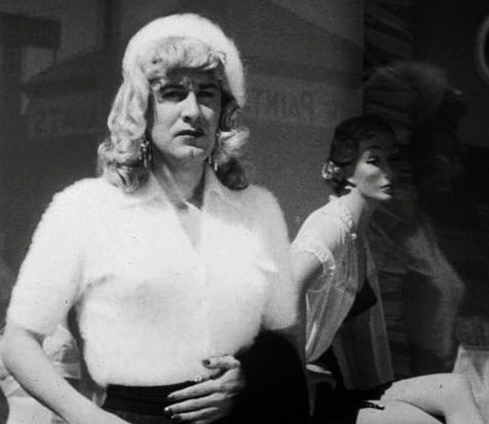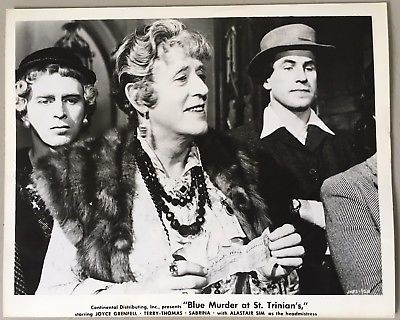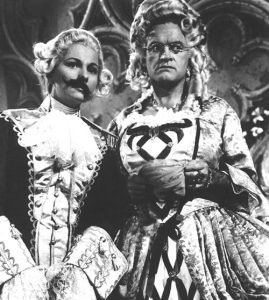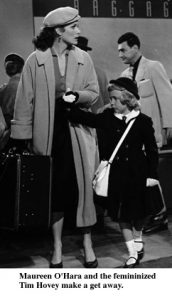Ed Wood and More ‘50s Drag in Cinema
Click on photos for a larger view.
A Retro Rerun By Laurie Sheril
With the end of World War II, motion pictures entered a new age. Somewhat a return to the age of innocence that films experienced in the silent era. Yes, it was mom, apple pie, Ozzie and Harriet, picket fences and all that! Not exactly the greatest environment for showing men dressed as women on film.
But with the post-war innocence came a few mavericks. The most famous of which was Ed Wood. He was to film making what an elephant is to a tutu. In other words: nothing. But seriously, whether Ed Wood had any talent at all has been debated. In this author’s humble opinion, he didn’t. Granted and true, his films had practically no budget, his actors had no experience, his scripts had no coherence and his directing was non-existent. But Ed Wood had one thing going for him (at least for US!), he was a transvestite. And in his first film he addressed the problems of transvestism and transsexuality in a way it had never before been spoken of in an American movie.
Glen or Glenda was a very sincere plea for understanding and compassion for Ts. Unfortunately, along the way, the “message” got lost in ludicrous dialogue, stock footage, Bela Lugosi’s rambling incantations, and some of the worst acting this side of last year’s senior class play. The sight of Ed Wood in drag was, I’m sure, jolting and no doubt funny to 1950s audiences.
The fact that he didn’t make (or perhaps try to make) a very attractive looking woman didn’t help. He did attempt to portray the anguished, heterosexual crossdresser coping with his desire, while struggling to tell his fiancée and convincing his own self that what he was doing was not wrong. Knowing of Wood’s own transvestism, we here in the ‘90s can appreciate his desire to make a serious picture out of a 50s “exploitation” picture.
In my pinion Ed Wood wasn’t really a transvestite. He merely had a fetish. In his case it was for angora sweaters and other “soft” garments. In order to wear his heart’s desire, though, it was necessary for him to wear all the other attire associated with a woman. I never saw any evidence that he liked to wear make-up, jewelry, high heels or such, but they were “required” so that he could wear the garments he did like.
The 1950s afforded filmmakers a time when they could make movies quickly and cheaply. Independent productions became more common as the advent of television and an anti-trust agreement which required movie studios to divest themselves of their theaters signaled the end of the majors dominance. Obviously Ed Wood was able to take advantage of this situation and got his films booked in less prestigious theaters and drive-ins.
Although Glen or Glenda was Ed Wood’s only film to tackle the subject of crossdressing and transsexuality as it’s main focus it was by no means the only film when Wood threw in a bit of drag for drag’s sake. His film, The Sinister Urge featured a brief scene with a policeman going undercover in drag. He was wearing what appears to be an angora sweater.
As Wood’s career declined he was forced to find a livelihood making porno films. In one of these, Take it Out in Trade he even appeared dressed in drag in a lime green dress, fluffy orange sweater (natch!), white plastic boots and blonde wig!
Of course Wood’s “camp classic” Plan 9 from Outer Space featured no crossdressing, but he will still be remembered as the father, er mother, of “transvestite cinema.” I’m sure he never in his wildest dreams thought somebody would make a multi-million dollar movie based on his life. Sure, Ed Wood the movie bombed at the box office, but nevertheless it did garner an Academy Award for actor Martin Landau for his portrayal of Bela Lugosi.
Ed Wood died December 10th, 1978, never realizing his greatest acclaim would come only after his death. Had he lived, he would probably have written a book about his life and gone on the talk show circuit to promote it. Wearing an angora sweater, no doubt!
Recommended Reading: Nightmare of Ecstasy: The Life and Art of Edward D. Wood, Jr. By Rudolph Grey, Feral House Books, 1994.
More From the Fifties
The Fifties was not the greatest decade for “drag in cinema.” In fact, it may have been the worst! Aside from Ed Wood (covered in the last installment), the instances of drag were few and far between. Maybe it was the shadow of Senator McCarthy, but whatever the reason, filmmakers did not give us many opportunities to see males in feminine finery in the Fifties!
One example, though, appeared in a series of films made in Great Britain. The St. Trinian’s films took place at a wacky girl’s school. In two entries in the series Alistair Sim played the part of Millicent Fritton, headmistress of the school. (Please note this was not a case of “drag” per se, but that of a male actor playing a female… something that, I guess, made it “socially acceptable” in the ’50s.) In both Belles of St. Trinian’s and Blue Murder at St. Trinian’s, Sim played the part of the dowager head of the school. Obviously this role was not one that required wearing anything remotely close to “sexy” clothes. Sim’s ample figure, though, was perfectly suited for the intended role.
An added bonus in Blue Murder… was character actor Lionel Jeffries, who played a jewel thief that had to resort to disguising himself as a headmistress of a girl’s polo team to elude the authorities. Jeffries’ character was just as dowdy as Sim’s, even though this was merely a disguise! There were other St. Trinian’s films, but these were the only two that featured drag in any form.
Bob Hope was always good for a few laughs in drag, and in the ’50s he put on a dress in Casanova’s Big Night (1954). In one scene, Hope gets in female drag disguise (while his co-star, Joan Fontaine gets into male-drag). Though Hope could have possibly looked good in his period dress, he came from the school of comedy that said just putting on the dress was enough for laughs… you didn’t have to look good in it.
Unlike Hope, Jerry Lewis was a comedian that rarely got into drag. He did do it twice in the ’50s, though (and once in the ’60s, we’ll cover that one later), in the films At War With the Army (1950) and 1953’s Scared Stiff. In the former he played a private who went AWOL. His disguise was a blonde wig and off-the-shoulder blouse (complete with hairy arms and chest.) Scared Stiff saw Lewis giving it his best in a Carmen Miranda impersonation (a favorite of FI’s of the ’40s and ’50s) in one of the movie’s funnier scenes.
One more bit of brief crossdressing occurs in the 1956 film, Everything But the Truth. Tim Hovey stars as a child who tells the truth… about everything. In one brief (very brief) scene, Hovey and star Maureen O’Hara have to make a “get-away.” O’Hara resorts to disguising the boy as a girl (complete with dress, purse, and mary-janes. It was an interesting bit of juvenile female impersonation… just too bad it was on and off the screen before you knew it.
Now, I have conspicuously left out one drag film of the 1950s. One that many be considered the best drag film ever made (well at least the best drag film ever made up until 1959!). That’s Some Like it Hot and we’ll use our entire column next month to cover it! See you then.
Care to make a comment on this post? Login here and use the comment area below.
Category: Transgender Fun & Entertainment, Transgender History

















Back in 1949 Alec Guinness played Aunt Agatha in “Kind Hearts and Coronets”. Actually, he played an entire family who were all murdered by a socially climbing nephew.
In 2007 “St. Trinian’s” updated the original film. Rupert Everett was the Headmistress, slightly less dowdy, and the girls were much better criminals this time around.
Let’s not forget that Alastair Sim was a classical British actor who created the definitive “Ebeneezer Scrooge”.
The British “got away” with drag because of the very long tradition of Pantomime on stage. While British law was for a long time very harsh toward gays having sex, drag has always been widely accepted. My guess is that it goes all the way back to Shakespeare’s time where women were not allowed on stage and men had to play all the roles.
Lots of “silly” drag took place in American movies when Vaudeville was going on. Drag was a regular comedy tradition in vaudeville — anyone besides myself remember Milton Berle regularly doing drag on TV back in the 1950’s? I loved going to The Jewel Box Revue in those days, but the appeal of drag, much like vaudeville, just went away for some reason. I’m glad to see it back!
Your mention of “Everything but the Truth” made me think of the Judy Garland film, “I Could Go on Singing”. Her son, in a British private school, is in a musical playing a female role. Fortunately for us, his female appearance lasts for quite a long while.